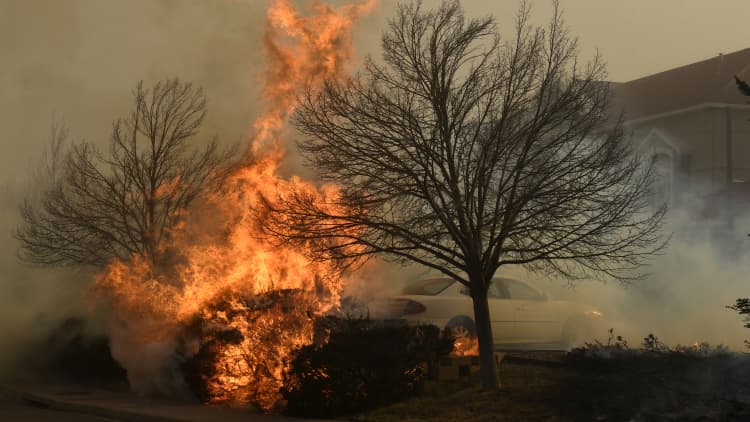The rare December blaze that tore through Boulder County, Colorado, at frightening speed this week may not be that unusual in the future, wildfire experts are warning, as climate change sets the stage for more.
Wildfires do not historically happen during the winter, particularly in areas like Boulder County, where the ground is normally moist from snow.
But in recent months, Colorado has experienced a severe drought. From July 1 through Dec. 29, 2021, Denver recorded its lowest amount of precipitation by over an inch, with snowfall at record low levels, too. Meanwhile, Boulder, which typically sees about 30 inches of snow between September and December, received just one inch in that period leading up to the day of the fire.
Combine that with an unseasonably warm fall, and the ground had significantly less moisture in it than it normally would — creating perfect conditions for a fire to flourish.
Read more from NBC News:
Subdued celebrations ring in 2022 around the world
"Everything is kind of crispy," said Keith Musselman, a snow hydrologist and assistant research professor at the University of Colorado Boulder. "In addition to the extreme drought, just one- or two-degree warmer days can really dry out the landscape quite a bit more, so everything is that much drier and flammable."
Officials say wind gusts of up to 105 mph fanned the flames, rapidly destroying between 500 and 1,000 homes and giving residents barely any time to evacuate.
While gusts of that magnitude are somewhat out of the ordinary for this time of year, they cannot be directly tied to climate change, said Daniel Swain, a climate scientist at the University of California Los Angeles and the nonprofit Nature Conservancy.

However, he said, climate change was definitely the reason the ground was primed for the wind-whipped fire to take off, and other areas may experience similar extensions of their wildfire seasons.
"Climate change is clearly making the pre-conditions for wildfires worse across most fire-prone regions of the world," he said.
In addition to the time of year during which it occurred, Colorado's fire stood out for another reason, said Philip Higuera, a professor of fire ecology at the University of Montana. Very few burn as many structures as this one did.
"Unfortunately, this illustrates one of the worst-case scenarios," he said of the fact that the blaze burned through densely populated neighborhoods. "These are these high-wind events under these extremely dry conditions and you're basically crossing your fingers and hoping there isn't a human-caused ignition in the wrong place."
Addressing the problem
The solution, the experts say, is two-pronged: Attacking climate change through actions and discussions within communities and households in the long term, and in the short term, not assuming that a certain area is immune from fires.
"We as a society need to recognize that wherever we're living in the West with vegetation is a fire-prone environment," Higuera said. "This can happen anywhere."
That might mean changing the way homes are built or reinforced to make them more fire-proof, or changing infrastructure so that power lines are buried or shut off during high-wind events, he said.
Officials initially suspected a downed power line as the cause of Thursday's blaze in Colorado but later said the investigation revealed there had not been any. They said they were continuing to investigate the cause.
While fires are likely to become more common year-round, Swain said winter still would not be a time of high fire activity.
"I still don't think winter is ever going to be peak fire season in the West," he said. "But it used to be a fire non-season, and I really don't think that's the case anymore."

